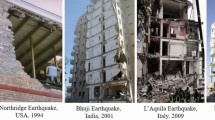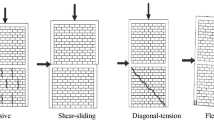Abstract
Numerical models are effective tools for analysis and design of structures. However, their potential often falls short while simulating the behavior of masonry structures because of their complex anisotropic nature. This complexity increases further for confined masonry (CM), where the masonry walls are confined within reinforced concrete members. Though some modeling schemes have been developed for analysis of CM walls, their applicability and accuracy are a matter of contention as they are based on different assumptions. Most design codes do not specify modeling schemes for CM due to limited research. Further, the limited modeling choices have not been validated sufficiently posing difficulty for practicing engineers in adopting them. Therefore, past numerical models of CM were first reviewed in this study. Then, simplified models such as wide-column model, strut-and-tie model, equivalent truss model, equivalent shell/strut model, and vertical–diagonal strut model were utilized to conduct gravity and lateral load analyses of CM walls having different aspect ratios. The comparative assessment between different models showed the efficacy of some schemes while exhibiting the ineffectiveness of others. Results of the nonlinear pushover analysis showed the best fitting models for capturing the experimental response of CM walls. The applicability of different models was also assessed by analyzing a three-story CM building under static pushover analysis. Thus, the study clarifies the pros and cons of different modeling schemes and provides ways for choosing an appropriate model for structural analysis, especially for nonlinear analysis required for performance-based design of single- or multi-story CM structures.















Similar content being viewed by others
Data availability
The datasets generated during and/or analysed during the current study are available from the corresponding author on reasonable request.
References
Aguilar G, Meli R, Diaz R. Vázquez-del-Mercado R (1996) Influence of horizontal reinforcement on the behavior of confined masonry walls. In: Proceedings of the eleventh world conference on earthquake engineering, 23–28 June 1996, Acapulco, Mexico, Elsevier Science Ltd, paper no. 1380
Ahmad N, Ali Q, Ashraf M, Khan AN, Alam B (2012) Performance assessment of low–rise confined masonry structures for Earthquake induced ground motions. Int J Civ Struct Eng 2(3):851–868
Ahmad N (2015) A note on the strong ground motions and behavior of buildings during 26th Oct. In: 2015 Afghanistan-Pakistan earthquake. Earthquake Engineering Research Institute, Oakland, CA
Amouzadeh Tabrizi M, Soltani M (2017) In-plane response of unreinforced masonry walls confined by reinforced concrete tie-columns and tie-beams. Adv Struct Eng 20(11):1632–1643
ASCE (2017) ASCE/SEI 41–17: seismic evaluation and retrofit rehabilitation of existing buildings. American Society of Civil Engineers
BIS (1987) Code of practice for design loads (Other Than Earthquake) for buildings and structures. Part 2: imposed loads. IS875-Part 2. Second revision. Bureau of Indian Standards, New Delhi
BIS (2000) Indian standard plain and reinforced concrete–code of practice. IS456. 4th revision. Bureau of Indian Standards, New Delhi
Borah B, Singhal V, Kaushik HB (2019) Sustainable housing using confined masonry buildings. SN Appl. Sci. 1(9):983
Borah B, Kaushik HB, Singhal V (2021a) Development of a novel V-D strut model for seismic analysis of confined masonry buildings. J Struct Eng 147(3):04021001
Borah B, Singhal V, Kaushik HB (2021b) Assessment of seismic design provisions for confined masonry using experimental and numerical approaches. Eng Struct 245:112864
Borah B, Kaushik HB, Singhal V (2022a) Lateral load-deformation models for seismic analysis and performance-based design of confined masonry walls. J Build Eng 48:103978
Borah B, Kaushik HB, Singhal V (2022b) Seismic force distribution in members of confined masonry buildings. Eng Struct 266:114605
Bourzam A, Ikemoto T, Miyajima M (2008) Lateral resistance of confined brick wall under cyclic quasi-static lateral loading. In: Proceedings of 14th world conference on earthquake engineering, Beijing, China
Brzev S, Mitra K (2018) Earthquake-resistant confined masonry construction, 3rd edn. National Information Center for Earthquake Engineering (NICEE), Indian Institute of Technology Kanpur, India
Brzev S, Gavilán, Pérez JJ (2016) Application of strut-and-tie model for seismic design of confined masonry shear walls. In: Proceedings 16th international brick and block masonry conference, Padova, Italy
Brzev S (2007) Earthquake-resistant confined masonry construction, 1st edn. National Information Center of Earthquake Engineering (NICEE), Indian Institute of Technology Kanpur, India
Chakra-Varthy P, Basu D (2021) Natural period and vertical distribution of base shear in confined masonry buildings using ambient vibration test. Bull Earthq Eng 19(4):1851–1899
Cruz O, Perez-Gavilan E, Flores C (2019) Experimental study of in-plane shear strength of confined concrete masonry walls with joint reinforcement. Eng Struct 182:213–226
Flores L, Alcocer SM (1996) Calculated response of confined masonry structures. In: Proceedings of 11th world conference on earthquake engineering, paper no. 1830, Acapulco, Mexico
Galvis FA, Miranda E, Heresi P, Dávalos H, Ruiz-García J (2020) Overview of collapsed buildings in Mexico City after the 19 September 2017 (Mw7. 1) earthquake. Earthq Spectra 36(S2):S83–S109
Gavilán Pérez JJ, Flores LE, Alcocer SM (2015) An experimental study of confined masonry walls with varying aspect ratios. Earthq Spectra 31(2):945–968. https://doi.org/10.1193/090712EQS284M
Ghaisas KV, Basu D, Brzev S, Gavilán JJP (2017) Strut-and-tie model for seismic design of confined masonry buildings. Constr Build Mater 147:677–700
Holmes M (1961) Steel frames with brickwork and concrete infilling. Proc Inst Civ Eng 19(2):473–478
Janaraj T, Dhanasekar M (2014) Finite element analysis of the in-plane shear behavior of masonry panels confined with reinforced grouted cores. Constr Build Mater 65:495–506
Kappos AJ, Penelis GG, Drakopoulos CG (2002) Evaluation of simplified models for lateral load analysis of unreinforced masonry buildings. J Struct Eng 128(7):890–897
Kaushik HB, Rai DC, Jain SK (2007) Stress-strain characteristics of clay brick masonry under uniaxial compression. J Mater Civ Eng 19(9):728–739
Kaushik HB, Rai DC, Jain SK (2009) Effectiveness of some strengthening options for masonry-infilled RC frames with open first story. J Struct Eng ASCE 135(8):925–937
Kaushik HB, Sanganee DA (2010) Analytical investigations of confined masonry constructions. In: Proceedings 3rd international earthquake symposium. Bangladesh University of Engineering and Technology, Dhaka, Bangladesh, and Bangladesh Earthquake Society, pp. 223–230
Kaushik HB, Rai DC, Jain SK (2008) A rational approach to analytical modeling of masonry infills in reinforced concrete frame buildings. In: Proceedings of 14th world conference on earthquake engineering, 12–17 October 2008, Beijing
Lagomarsino S, Penna A, Galasco A, Cattari S (2013) TREMURI program: an equivalent frame model for the nonlinear seismic analysis of masonry buildings. Eng Struct 56:1787–1799
Magenes G, Fontana AD (1998) Simplified non-linear seismic analysis of masonry buildings. In: Proceedings of fifth international masonry conference, British masonry society. No. 8. pp 190–195
Mahdi T, Rezvaniasl R (2008) Simplified modeling of confined masonry walls. In: 12th international conference on computing in civil and building engineering, Beijing
Marinilli A, Castilla E (2004) Experimental evaluation of confined masonry walls with several confining-columns. In: Proceedings of 13th world conference on earthquake engineering, paper no. 2129, Vancouver, British Columbia
Marques R, Lourenço PB (2013) A model for pushover analysis of confined masonry structures: implementation and validation. Bull Earthq Eng 11(6):2133–2150
Marques R, Lourenço PB (2019) Structural behaviour and design rules of confined masonry walls: Review and proposals. Constr Build Mater 217:137–155
Marques R, Pereira JM, Lourenço PB (2020) Lateral in-plane seismic response of confined masonry walls: from numerical to backbone models. Eng Struct 221:111098
Matošević Ɖ, Sigmund V, Guljaš I (2015) Cyclic testing of single bay confined masonry walls with various connection details. Bull Earthq Eng 13(2):565–586
Medeiros P, Vasconcelos G, Lourenço PB, Gouveia J (2013) Numerical modeling of non-confined and confined masonry walls. Constr Build Mater 41:968–976
Meli R, Brzev S, Astroza M, Boen T, Crisafulli F, Dai J, Farsi M, Hart T, Mebarki A, Moghadam AS, Quinn D (2011) Seismic design guide for low-rise confined masonry buildings. Publication WHE – 2011 – 02, World Housing Encyclopedia, Earthquake Engineering Research Institute (EERI), Oakland, California
NTC-M (2004) Complementary technical norms for design and construction of masonry structures. Mexico City building code, Gaceta Oficial del Distrito Federal, Mexico
Okail H, Abdelrahman A, Abdelkhalik A, Metwaly M (2016) Experimental and analytical investigation of the lateral load response of confined masonry walls. HBRC J 12(1):33–46
Parammal Vatteri A, D’Ayala D (2021) Classification and seismic fragility assessment of confined masonry school buildings. Bull Earthq Eng 19(5):2213–2263
Paulay T, Priestley MJN (1992) Seismic design of reinforced concrete and masonry buildings. Wiley-Interscience, New York
Polyakov SV (1956) Masonry in framed buildings: an investigation into the strength and stiffness of masonry infilling. Published by Gosudarstvennoe izdatel’stvo literatury po stroitel’stvu i arkhitekture, Moscow (Translation into English by G. L. Cairns)
Rangwani K, Brzev S (2017) Seismic analysis of confined masonry shear walls using the wide column model. Appl Mech Mater 857:212–218
Ranjbaran F, Hosseini M, Soltani M (2012) Simplified formulation for modeling the nonlinear behavior of confined masonry walls in seismic analysis. Int J Archit Herit 6(3):259–289
Rankawat N, Brzev S, Jain SK, Gavilan JJP (2021) Nonlinear seismic evaluation of confined masonry structures using equivalent truss model. Eng Struct 248:113114
Riahi Z, Elwood KJ, Alcocer SM (2009) Backbone model for confined masonry walls for performance-based seismic design. J Struct Eng 135(6):644–654
Schlaich J, Schäfer K, Jennewein M (1987) Toward a consistent design of structural concrete. PCI J 32(3):74–150
Singhal V, Rai DC (2016) In-plane and out-of-plane behavior of confined masonry walls for various toothing and openings details and prediction of their strength and stiffness. Earthq Eng Struct Dyn 45(15):2551–2569
Smoljanović H, Živaljić N, Nikolić Ž, Munjiza A (2017) Numerical model for confined masonry structures based on finite discrete element method. Int J Eng Model 30(1–4):19–35
Stafford-Smith B (1962) Lateral stiffness of infilled frames. J Struct Div 88(6):183–199
Terán-Gilmore A, Zuñiga-Cuevas O, Ruiz-García J (2009) Displacement-based seismic assessment of low-height confined masonry buildings. Earthq Spectra 25(2):439–464
Tomaževič M, Klemenc I (1997) Seismic behaviour of confined masonry walls. Earthq Eng Struct Dyn 26(10):1059–1071
Torrisi G, Crisafulli F (2017) Computational implementation of an improved masonry panel element. In: Proceedings of 16th world conference on earthquake engineering, Santiago, Chile
Torrisi G, Crisafulli FJ, Pavese A (2012) An innovative model for the in-plane nonlinear analysis of confined masonry and infilled frame structures. In: Proceedings of 15th world conference on earthquake engineering. pp 24–28
Tripathy D, Singhal V (2019) Estimation of in-plane shear capacity of confined masonry walls with and without openings using strut-and-tie analysis. Eng Struct 188:290–304
Wight JK, MacGregor JG (2005) Reinforced concrete: mechanics and design, 5th edn. Prentice Hall, Upper Saddle River, NJ
Wijaya, W., Kusumastuti, D., Suarjana, M., Rildova, Pribadi, K. (2011). Experimental study on wall-frame connection of confined masonry wall. Procedia Eng 14, 2094–2102. https://doi.org/10.1016/j.proeng.2011.07.263
Yacila J, Camata G, Salsavilca J, Tarque N (2019) Pushover analysis of confined masonry walls using a 3D macro-modelling approach. Eng Struct 201:109731
Funding
Authors gratefully acknowledge the Grant received from the Science and Engineering Research Board, Department of Science and Technology, Government of India (Grant No. ECR/2018/000489).
Author information
Authors and Affiliations
Contributions
The study was conceptualized and designed by BB, and she carried out all the analysis reported in the manuscript. Resources and supervision were provided by HBK and VS. The first draft of the manuscript was written by BB and all authors commented on previous versions of the manuscript. All authors have read and approved the final manuscript.
Corresponding author
Ethics declarations
Conflict of interest
The authors have no relevant financial or non-financial interests to disclose.
Additional information
Publisher's Note
Springer Nature remains neutral with regard to jurisdictional claims in published maps and institutional affiliations.
Rights and permissions
Springer Nature or its licensor (e.g. a society or other partner) holds exclusive rights to this article under a publishing agreement with the author(s) or other rightsholder(s); author self-archiving of the accepted manuscript version of this article is solely governed by the terms of such publishing agreement and applicable law.
About this article
Cite this article
Borah, B., Kaushik, H.B. & Singhal, V. Evaluation of modeling strategies for gravity and lateral load analysis of confined masonry structures. Bull Earthquake Eng 21, 1273–1301 (2023). https://doi.org/10.1007/s10518-022-01578-7
Received:
Accepted:
Published:
Issue Date:
DOI: https://doi.org/10.1007/s10518-022-01578-7




